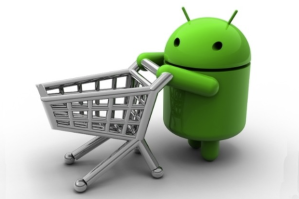A study of the free shopping apps in the Android Play store shows that the most popular apps fall into the broad categories that one would reasonably expect without pushing the limits of imagination: pure play e-commerce, brick-and-mortar retailer apps, coupons & deals, utilities (shopping lists, product scans, loyalty storage) and rewards for shopping behavior [see list at bottom of post]. In general, the most popular shopping apps are not revolutionary in terms of offering consumers a compelling shopping experience that they can’t find elsewhere. As a result, fewer than 50% of consumers who download the most popular mobile shopping apps are developing regular usage habits. A recent NPD study showing that within 3 months of downloading a retailer’s app, 75% of consumers stop using the app even once a month. The same study shows that more consumers use retailer web sites than apps (71% of consumers vs 57%), perhaps indicating they prefer accessing a retailer’s website on an irregular basis than going through the trouble of downloading a mobile app.
One of the reasons for the lack of regular usage of top mobile shopping apps may be that the majority take a conventional shopping task focused view of a person’s motivations & intentions for using a mobile app, eg. “the user wants to purchase something specific/find coupons/compare products”. Very few take a time-based view of a person’s motivations & intentions for using a mobile app, eg. “the user has many small moments of downtime in the day that they’d like to fill with an engaging app experience”. Most shopping and retail apps are not focusing on the way that consumers spend their free time interacting with their smartphone. Horace Dediu had a fantastic recent post “Of bits and big bucks” in which he made the following observation:
Consumers have a fixed time budget, a more rigid constraint than their spending budget. Competition for a slice of a consumer’s time budget is far tougher than competition for a slice of a consumer’s wallet. So what’s amazing is that apps have successfully grabbed a share of this time budget. I believe that the reason they succeeded is that they initially fit into niche time slices that were previously unoccupied.
Social networks, games, media and messaging have captured the majority of the mobile phone user’s fixed time budget, according to a Flurry report from April 2013. But time spent with mobile devices is growing, and there is room for shopping apps to capture a share of consumers’ time budgets. One way to do this will be to mimic the social, interactive, gaming, media/content experiences of the most popular app categories. In shopping, the examples of social & interactive apps include Pinterest, Wanelo, Poshmark and Luvocracy. The example of “game-like” apps include the time-sensitive, flash sale or discount experiences provided by Groupon, LivingSocial, Gilt and Hautelook. And the “content”-based apps include apps like JackThreads and ModCloth that have an oft-refreshed curated selection with a strong editorial point of view. Each of these strategies helps to capture a slice of a consumer’s time budget with a compelling experience that drives repeat visits and a desire for regular interaction with the app. Moving forward, I expect that we will see shopping apps that focus on capturing regular, limited slices of a consumer’s time budget to rapidly gain popularity and move into the top 50 in the mobile app store rankings. Because the consumer time budget is waiting to be filled, and the most downloaded shopping apps of today aren’t getting the job done.
———————————–
Android Top 50 Free Shopping Apps (January 12, 2014)* : eBay, Amazon, Groupon, Craigslist, Barcode Scanner, Walgreens, Wish, Walmart, RetailMeNot, Retale, Target, Amazon Local, Costco, Checkout 51, The Coupons App, Etsy, RedLaser, Best Buy, LivingSocial, JackThreads, Key Ring, Wanelo, Zappos, Out of Milk, ShopSavvy, Shopular, Home Depot, Lowe’s, Kroger, Sam’s Club, Newegg, Ibotta, Coupons.com, Favado, Macy’s, Shopkick, AT&T Code Scanner, Overstock.com, Nomorerack, QVC, Autozone, SnipSnap, Sears, Slickdeals, OpenSky, KMart, Meijer, Zulily, Scantopia, Grocery IQ
E-commerce (17): eBay, Amazon, Groupon, Craigslist, Wish, Amazon Local, Etsy, LivingSocial, JackThreads, Wanelo, Zappos, Newegg, Overstock.com, Nomorerack, QVC, Zulily, OpenSky
Traditional retail (14): Walgreens, Walmart, Target, Costco, Best Buy, Home Depot, Lowe’s, Kroger, Sam’s Club, Macy’s, AutoZone, Sears, Meijer, KMart
Coupons (8): RetailMeNot, Retale, The Coupons App, Shopular, Coupons.com, Favado, SnipSnap, Slickdeals
Shopping utilities (7): Barcode Scanner, RedLaser, Key Ring, Out of Milk, ShopSavvy, AT&T Code Scanner, Grocery IQ
Shopping Rewards (4): Checkout 51, Ibotta, Shopkick, Scantopia
* Edited out a handful of apps that weren’t “shopping” related; Pinterest is not included in Play’s “Shopping” category, but it would slot in after eBay at #2 if it were included.
